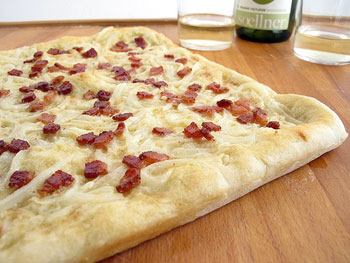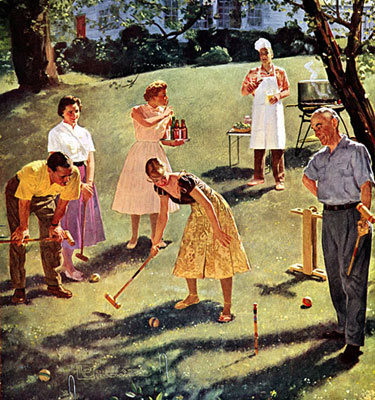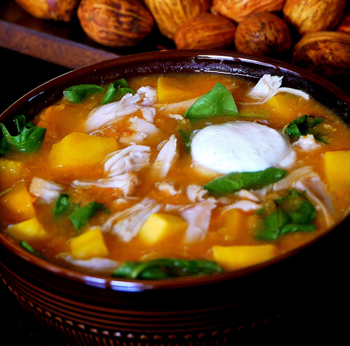 I am very much intrigued by the unique food of Alsace, the tiny region that shares a border and many culinary similarities with Germany. My love for Alsatian food stems from my visit a few years ago to The Modern, which is run by Alsatian chef Gabriel Kruether. There I enjoyed many traditional Alsation dishes, among them a tarte flambée, a simple pizza-like tart. It is also known as flammekueche in Alsatian or flammkuchen in German. It's fundamentally a very simple combination of smoky bacon, sautéed onions, and rich cream on a crispy bread that forms a most amazing salivatingly savory meal.
I am very much intrigued by the unique food of Alsace, the tiny region that shares a border and many culinary similarities with Germany. My love for Alsatian food stems from my visit a few years ago to The Modern, which is run by Alsatian chef Gabriel Kruether. There I enjoyed many traditional Alsation dishes, among them a tarte flambée, a simple pizza-like tart. It is also known as flammekueche in Alsatian or flammkuchen in German. It's fundamentally a very simple combination of smoky bacon, sautéed onions, and rich cream on a crispy bread that forms a most amazing salivatingly savory meal.
The flavors I experienced that day still linger in my memory. I knew then that I would try and re-create this Alsatian tart at home. But it wasn't until last week that the thought crossed my mind once I discovered my local supermarket sold crème fraîche, the French sour cream, which is a necessary ingredient for this recipe. To recreate the flavor profiles of the tart I enjoyed at the restaurant, I also searched for applewood-smoked bacon, which I was also luckily able to procure. With all the ingredients in hand, I was now absolutely ready to bake and devour a traditional tarte flambée.
Retro Recipes and Traditional Fare
Retro Recipes and Traditional Fare
Traditional Chicken Kiev
 I was recently in St Petersburg Russia and had a great lunch at Tsar Restaurant (note: avoid bottled water, each one cost $25). I decided to try the Chicken Kiev, which was pretty common on the restaurant menus in St. Petersburg, and it seemed so “Russian” (though I later discovered that it’s not).
I was recently in St Petersburg Russia and had a great lunch at Tsar Restaurant (note: avoid bottled water, each one cost $25). I decided to try the Chicken Kiev, which was pretty common on the restaurant menus in St. Petersburg, and it seemed so “Russian” (though I later discovered that it’s not).
Chicken Kiev is actually French in origin. Russian aristocracy became very interested in French cuisine in the 1700s and they would send their Russian chefs to France to train or bring French chefs into Russia. A French chef called Nicolas Francois Appert invented Chicken Kiev in the early 1800s. Appert's invention became famous and Russian chefs tried to imitate Chicken Kiev, calling the dish "cotelettes de volaille" instead of Chicken Kiev.
Early restaurants in New York City changed the name back to Chicken Kiev, in an attempt to attract the new Russian immigrants and this name stuck. Traditionally, it is deep fried in oil, but I found a recipe from America’s Test Kitchen that achieves the same crisp coating with frying.
The Perfect Paella
 A couple of summer months filled with many beachside lunches of paella so good and so long ago that I am still chasing the memories of a perfect paella. My sister and I were in the Catalonian village of Arenys de Mar for a good part of the summer. On the wide, white beach surrounded by rugged hills were a handful of rustic 'restaurants' that made only paella over wood fires. They were makeshift structures covered with bright pieces of miss-matched canvas tacked down to keep the strong Spanish sun and ocean breeze at bay. These little makeshift restaurants were always busy for lunch, the only meal that they served and I had my favorite one.
A couple of summer months filled with many beachside lunches of paella so good and so long ago that I am still chasing the memories of a perfect paella. My sister and I were in the Catalonian village of Arenys de Mar for a good part of the summer. On the wide, white beach surrounded by rugged hills were a handful of rustic 'restaurants' that made only paella over wood fires. They were makeshift structures covered with bright pieces of miss-matched canvas tacked down to keep the strong Spanish sun and ocean breeze at bay. These little makeshift restaurants were always busy for lunch, the only meal that they served and I had my favorite one.
The beach side paella restaurateurs were waiting like gulls as the little boats motored back to port around 10 o’clock in the morning. Each boat filled with the fresh caught fish and shellfish still moving violently seeking to be set free. There was fish to fillet and chunk, stock to make, onions and peppers to chop and most importantly the wood-fire had to be started, time was of the essence.
My favorite restaurant had a round stone fire pit built on the sand. A variety of wood collected from the beach was piled into the pit covering yesterday's scrunched up newspaper which was barely visible in the center. A wooden match was struck and the day's cooking commenced. When the flames burned down, the cook balanced a grill on top of the stone pit.
Quick Chicken Marengo
 Chicken Marengo is an amazing Italian savory dish named for being themeal Napoleon Bonaparte feasted on after the Battle of Marengo (a battle between the French and the Austrians in the 1800s).
Chicken Marengo is an amazing Italian savory dish named for being themeal Napoleon Bonaparte feasted on after the Battle of Marengo (a battle between the French and the Austrians in the 1800s).
Apparently Napoleon demanded a quick meal once the battle ended. His chef was forced to come up with something great with only meager supplies on hand; chicken (and some eggs), tomatoes, onions, garlic, herbs, olive oil and crayfish. The chicken was allegedly cut up with a sabre and fried in olive oil.
A sauce was made from tomatoes, garlic and onions (even some Cognac from Napoleon's flask) while the crayfish was cooked up on the side and all was served over eggs with some of the soldier's bread ration on the side. Napoleonraved overthe food and since he had won the battle, considered this dish lucky. On future occasions Napoleon refused to have the ingredients altered, even when his chef wanted to omit the crayfish.
Modern versions of this dish, such as this one, leave out the crayfish and add olives for flavor. Serving this over polenta also makes this comfort food to the max. The flavors are over the top and you will love how moist the chicken becomes.
You have to try this, you will love, love, love it!!
How I Discovered Fromage Fort
 Years ago when I was a round nugget of a child running around in terry-cloth shorts I had a book I read to myself many times over. It involved some Amphibian or Owl With Shoes who lived inside a mushroom or hollow tree. I can’t remember much of the story but the one thing that stuck in my brain was that on many occasions this anthropomorphic critter would find himself without food or drink and would simply chop an onion or think about sad things in order to create his own version of tear tea. I remember being disgusted by the thought of sipping one’s own saline tears but that didn’t freak me out as much as the things he’d think about to coax the tears out of his eyes and into the kettle.
Years ago when I was a round nugget of a child running around in terry-cloth shorts I had a book I read to myself many times over. It involved some Amphibian or Owl With Shoes who lived inside a mushroom or hollow tree. I can’t remember much of the story but the one thing that stuck in my brain was that on many occasions this anthropomorphic critter would find himself without food or drink and would simply chop an onion or think about sad things in order to create his own version of tear tea. I remember being disgusted by the thought of sipping one’s own saline tears but that didn’t freak me out as much as the things he’d think about to coax the tears out of his eyes and into the kettle.
Torn books, uneaten mashed potatoes, no internet (ok I added that) and stubby chewed-up pencils that were no longer needed and left to roll behind the oven, never to be seen again. As a kid I could see those pencils laying there waiting to be found, just looking up at the ceiling thinking “I’m still good! Please! Anyone, I Can Still Make Notes And Drawings For You, I Promise You! Please? I’ll be good!” and wouldn’t you know I would begin sobbing every single time I got to that damn part of the story! Here’s where it gets bad – and you might want to stop reading here – the lead character would fill his pot up, wipe his eye, smile and exclaim something like “Tea’s Ready!” and flutter away.
What the hell? Did you really get my 5-year old emotions in a tizzy so you could have tea and then just walk away smiling? What about me? What about those pencils? They are still there, tiny and little, craving the warmth of a human hand! That hasn’t changed just because your thirst has been sated! You goshdarn son of a bitch dirty bird!
More Articles ...
Welcome to the new One for the Table ...
Our Home Page will be different each time you arrive.
We're sure you'll find something to pique your interest...


